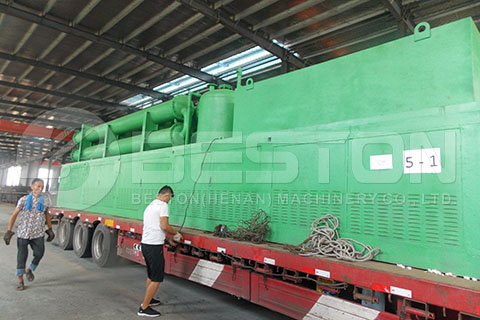The continuous pyrolysis plant is one of the best ways to deal with waste such as oil sludge, rubber, plastic, and waste tyres. These plants are designed with a number of different benefits.
To begin with, the Beston continuous pyrolysis plants feature a handling capacity that is large of 20-24t/d, making these plants the ideal solution for the large factories or for businesses looking to dispose of large amounts of waste.

This pyrolysis plant comes equipped with a feeder that is automatic. This provides a way to automatically feed the waste tyres into the reactor, which drastically reduces costs and manpower. The continuous pyrolysis plant also comes with a shredder machine. This machine crushes the waste tyres into smaller pieces of around 40mm, which helps to maximize the efficiency of pyrolysis.
These plants are also designed to run continuously for 24-hours a day without the need to stop. This waste pyrolysis plant is able to discharge slags and feed materials into the reactor simultaneously. When compared to the traditional types of pyrolysis plants, the continuous p0yrolysis plants help to save on fuels and time.
The most important advantage of the continuous pyrolysis plant has to do with the reactor which is not rotary, but rather stable. This assists with a faster and more even heating of the reactor.

Operation Description Of Continous Tyre Pyrolysis Plant
1. Pre-Treatment
Before the pyrolysis process begins, the waste tyres need to undergo a pre-treatment phase. This includes the shredder machine that breaks down the waste tyres into smaller pieces of around 30 to 55mm.
2. Feeding The Raw Materials
After the pre-treatment phase, the waste materials are automatically fed into the pyrolysis reactor. The inlet door is then sealed tightly to prevent any gas leakages.
3. Pyrolysis
The waste pyrolysis plant is first heated using a fuel source such as wood, coal, fuel gas, or charcoal. The reactor gradually heats up and once the temperature rises to 250℃, the burning process produces an oil gas.
4. Condensing
The oil gas produced inside the reactor is then sent into the condensing-system, where the gas is converted into liquid oil.
5. Recovery Of Waste Gas
The gas that does not liquefy under standard pressure will be sent through a safety device back into the combustion-system. This recycled gas is then used to provide the fuel the reactor, which saves on energy throughout the working process.
6. Discharge
The steel wire and carbon black is then automatically discharged, and any waste materials are sent back into the reactor.
Final Products From Continous Tyre Pyrolysis Plant
• Tyre Oil
This oil is used widely as an industrial fuel material. The oil can also be further refined to gasoline or diesel, which is used in low-speed engines such as loading machines, road rollers, and digging machines.
• Carbon Black
The carbon black is used frequently to construct the bricks made from clay. It is also made into briquettes or pellets, for burning.
• Steel Wire
The reclaimed steel wire discharged from the continuous tyre pyrolysis plant is recycled again and used to produce iron and steel rods.